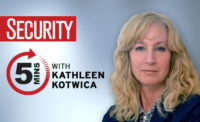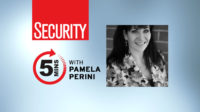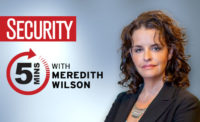Jennifer Urban, an aviation attorney currently working as a consultant, talks to Security magazine about her career in aviation law and the different risks found in aviation security. She also discusses how the pandemic has brought on new challenges in aviation security and suggests ways to keep travelers safe (and calm) throughout their journeys.
Security magazine: Could you please tell me a little bit about your journey as an attorney and what led you to your current position in aviation security?
Urban: I went to law school at the University of Mississippi, which has an LLM [degree] in air and space law. [I] knew I wanted to be in the niche of aviation law, [and] decided that regulatory and security as well as crisis management was really the area that I wanted to go into.
I started off in private practice working with airlines, airports, manufacturers and lots of different regulators such as the FAA, TSA, DOT, DHS, as well as international regulators and industry groups. That was fascinating; I loved a lot of the projects I worked on, really on the legal side of things, representing the companies within a private practice field. Then I moved around and moved into working within airport security and really enjoyed that. That was a lot different because it was not always as legal-based. I think it was key to have the legal knowledge in my positions there where I was in aviation relations and compliance, because having a legal knowledge allowed me to negotiate for mutually beneficial solutions for all parties involved, as well as played a huge role in being able to interpret airport security plans.
That's how I moved into airports, really learning to love all the security concerns within the airports, because airports are the first start in the journey of aviation. Then it led me into crisis management, which I absolutely love. I never want crises to occur, however I do enjoy managing them.
It's never boring in aviation.
Security magazine: What would you say are some of the biggest challenges in aviation security?
Urban: There's quite a few, I'll start out with a couple of the main ones. One that I see being a large aspect, especially as technology continues to evolve, is cybersecurity. There [are] many cybersecurity concerns and ensuring that every person or partner that works within the airport has strict cybersecurity policies and standards — It’s hard when you have so many different people working in aviation: baggage handling, cargo companies, airport security companies [or] any contractors that are working there. If everyone doesn’t have strict cybersecurity standards, that can lead to huge issues.
Another one that I think I wouldn’t have necessarily said if we were back in 2019 — it has always been an issue but I’ve seen a lot lately — is unruly passengers. The FAA had received 3,715 reports just this year of unruly passengers and were urging airport managers and airport law enforcement to arrest unruly passengers, so that [they] not only face a fine, but also the threat of criminal charges.
Finally, I would say another aspect of security in aviation is unmanned aircraft [or] drones. You might think, “Well, drones aren’t a part of aviation.” They absolutely are and they can be extremely helpful within the aviation industry. However, they also cause a lot of issues.
Security magazine: Is there a certain process you go through when assessing security risks in aviation? What are some examples of common risks you see?
Urban: I think it really just depends on which area you’re working in. I know that TSA, they use a lot of different technology to assess the risks, as well as obviously screening and those sorts. You also want to be able to utilize technology to understand the risks such as insider threats. What technology can be used to assess those risks? How are background checks being kept up for new hires? If a current employee has had issues or criminal charges filed against them, are those being properly reported?
[Another tool is] using human behavioral detection methods. If you see someone that’s acting unruly or acting upset or something might not be right, make sure that people are trained in [response tactics]. [It’s important to ensure you are] using technology and human detection services to be able to assess all risks in that regard.
Security magazine: What are some ways to help regulate physical security in aviation?
Urban: Like I mentioned earlier, every step matters. A lot of airports have been focusing on the customer journey. Of course, they want to have great customer service, but when the customer journey is easy for the passenger and less stressful, I think that keeps everyone’s minds a little bit cooler; [people are] less likely to get upset or even more stressed out. This may sound silly, but a lot of airports are putting in fountains, gardens or therapy rooms, where it's just ways to keep [passengers] calm. That’s one way to help start off the journey right.
The [next step is] utilizing security technology. One of the big issues [the TSA] has seen lately is firearms being taken to the airport. Now that doesn't necessarily mean that every person that's going through and caught with a firearm is a bad actor. But it’s about ensuring that that's not going through [security].
Also, TSA officers are trained to keep [an eye] out for suspicious situations or people not acting right. They have focused on an anti-human trafficking measure so they’re using technology, the human detection behavior capabilities that I stated earlier, as well as insider threat prevention.
[The] TSA [follows], “See something, say something,” and that’s really key, encouraging passengers [and anyone that works in an airport] to [communicate when they see something suspicious].
Then one thing that I was especially involved in is intensive auditing. You may have all these procedures and regulations, but are they actually taking place the way they’re meant to? Is the baggage getting loaded properly? Is it getting screened properly? Is cargo getting screened properly? Are the flight crews helping keep passengers calm while doing their safety procedures as well?
I think in regards to the intensive auditing measures, regulators and leaders really need to be involved in the ground steps. That’s a key aspect, especially [one] I've learned from crisis management. If the leaders don’t actually know what goes on the ground, they shouldn’t be the ones making the decisions, [especially] if they don't quite understand the whole situation.
The above transcript has been edited for clarity.
Listen to this episode of Security's Women in Security podcasts now:



